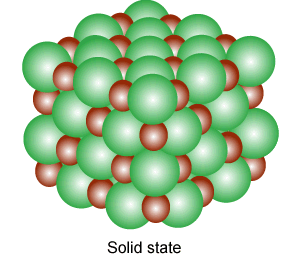Edge length of a unit cell of a crystal is 288 pm. If its density is 7.2 g/cm3, then determine the type of unit cell assuming mass = 52 g.
Edge length of a unit cell of a crystal is 288 pm. If its density is 7.2 g/cm3, then determine the type of unit cell assuming mass = 52 g.
Solution and Explanation
We can use the formula for the density of a crystal in terms of its unit cell parameters:
\[ \rho = \frac{ZM}{V N_A} \]
where:
- \(\rho\) is the density of the crystal,
- Z is the number of atoms per unit cell,
- M is the molar mass of the substance,
- V is the volume of the unit cell,
- \(N_A\) is Avogadro's constant.
Step 1: Calculate the volume of the unit cell:
To determine the type of unit cell, we first need to calculate the volume of the unit cell using the edge length. For a cubic unit cell, the volume is given by:
where \(a\) is the edge length of the unit cell.
Substituting the given values, we get:
\[ V = (288 \, \text{pm})^3 = (288 \times 10^{-12} \, \text{m})^3 = 2.359 \times 10^{-23} \, \text{m}^3 \]Step 2: Use the formula for density to solve for Z:
Now that we know the volume, we can use the formula for density to solve for \(Z\), the number of atoms per unit cell:
Substituting the given values into the equation:
\[ 7.2 \, \text{g/cm}^3 = \frac{Z \times 52 \, \text{g/mol}}{2.359 \times 10^{-23} \, \text{m}^3 \times 6.022 \times 10^{23} \, \text{mol}^{-1}} \]Simplifying the equation to solve for \(Z\):
\[ Z = \frac{7.2 \, \text{g/cm}^3 \times 2.359 \times 10^{-23} \, \text{m}^3 \times 6.022 \times 10^{23}}{52 \, \text{g/mol}} \]After evaluating the equation, we get:
\[ Z \approx 4 \]Step 3: Determine the unit cell type:
The value of \(Z = 4\) suggests that the crystal has a face-centered cubic (FCC) unit cell. In an FCC structure, there are 4 atoms per unit cell, with atoms located at the corners and at the center of each face of the cube.
Conclusion:
Therefore, we can conclude that the crystal has a face-centered cubic (FCC) structure.
Top Questions on The solid state
- If three elements A, B, C crystallize in a cubic solid lattice with B atoms at the cubic centres, C atoms at the centre of edges, and A atoms at the corners, then the formula of the compound is:
- WBJEE - 2025
- Chemistry
- The solid state
- Which of the following transition elements has both bcc and ccp structures at normal temperature?
- KEAM - 2025
- Chemistry
- The solid state
- A metal crystallizes with hcp packing. The total number of voids, total number of tetrahedral voids and total number of octahedral voids are shown as A, B and C respectively. A, B and C in 0.25 moles of metal are respectively ($N_A$ = Avogadro number).
- AP EAPCET - 2025
- Chemistry
- The solid state
- An element crystallizes in bcc lattice. The atomic radius of the element is 2.598 \AA. What is the volume (in cm$^3$) of one unit cell?
- AP EAPCET - 2025
- Chemistry
- The solid state
- A metal crystallizes in simple cubic lattice. The radius of the metal atom is $x\, pm$. What is the volume of the unit cell in $pm^3$?
- AP EAPCET - 2025
- Chemistry
- The solid state
Questions Asked in MHT CET exam
- Which of the following solutions will show highest freezing point depression?
- MHT CET - 2025
- Colligative Properties
- Given the formula for depression of freezing point: \[ \Delta T_f = K_f \cdot m \] where \( \Delta T_f \) is the depression of freezing point, \( K_f \) is the freezing point depression constant, and \( m \) is the molality, calculate the value of \( m \).
- MHT CET - 2025
- Colligative Properties
- Which of the following coordination compounds exhibits geometrical isomerism?
- MHT CET - 2025
- coordination compounds
- What is the pH of a 0.01 M hydrochloric acid (HCl) solution?
- MHT CET - 2025
- Acids and Bases
- What is the molar concentration of hydrogen ions in a solution of $ 0.1 \, \text{M} $ $ \text{HCl} $?
- MHT CET - 2025
- Acids and Bases
Concepts Used:
Solid State
Solids are substances that are featured by a definite shape, volume, and high density. In the solid-state, the composed particles are arranged in several manners. Solid-state, in simple terms, means "no moving parts." Thus solid-state electronic devices are the ones inclusive of solid components that don’t change their position. Solid is a state of matter where the composed particles are arranged close to each other. The composed particles can be either atoms, molecules, or ions.

Types of Solids:
Based on the nature of the order that is present in the arrangement of their constituent particles solids can be divided into two types;
- Amorphous solids behave the same as super cool liquids due to the arrangement of constituent particles in short-range order. They are isotropic and have a broad melting point (range is about greater than 5°C).
- Crystalline solids have a fixed shape and the constituent particles are arranged in a long-range order.